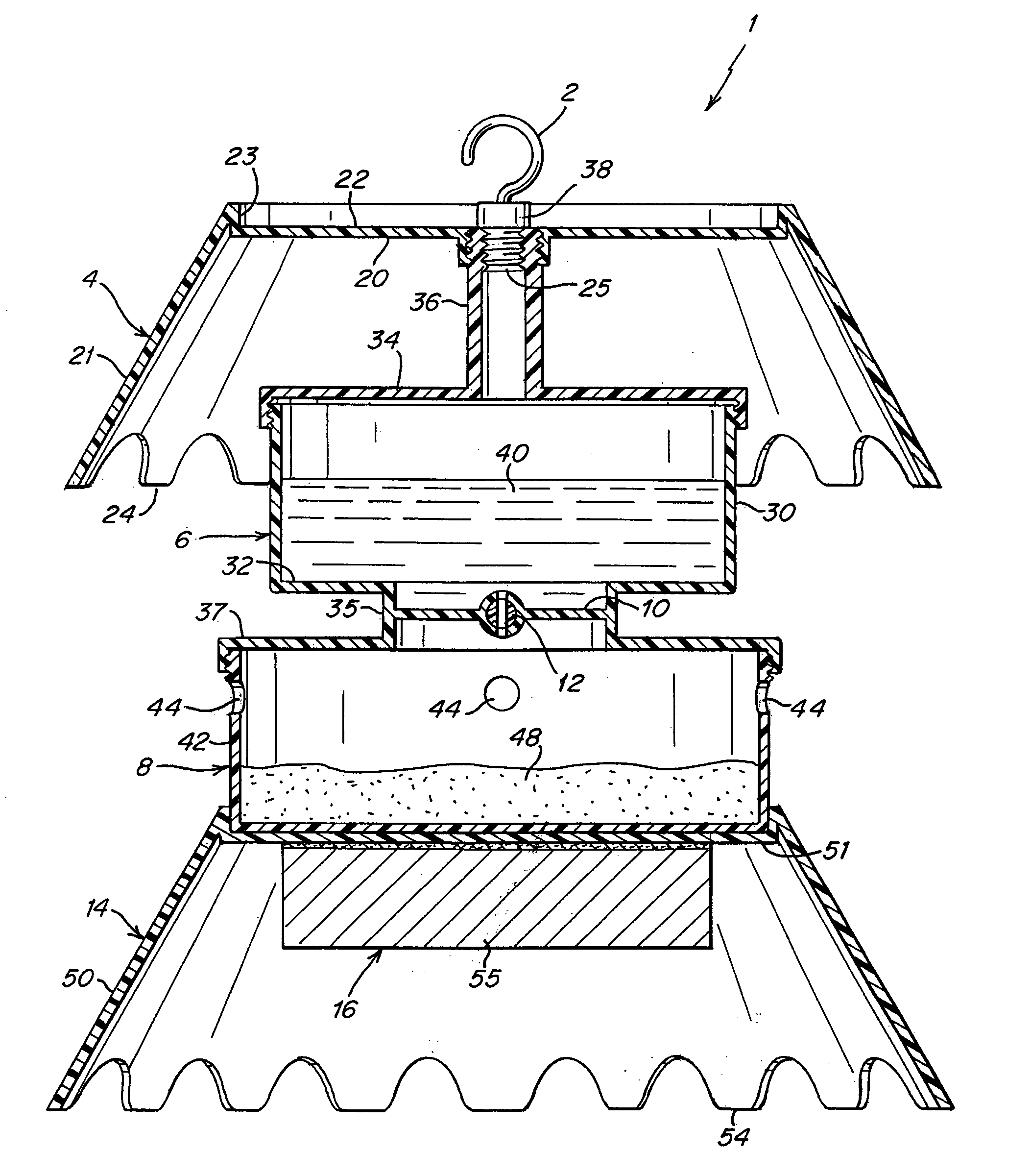Insect/arthropod trap
- Summary
- Abstract
- Description
- Claims
- Application Information
AI Technical Summary
Benefits of technology
Problems solved by technology
Method used
Image
Examples
example 2
[0046] 500 ml of H.sub.2O is drip wicked by a conveyor at a rate of 2 ml / hr from an upper container to a chamber below containing 180 g C.sub.3H.sub.6O.sub.3, 453 g sodium bicarbonate CHN.sub.aO.sub.3, 80 g urea H.sub.2NCONH.sub.2. The subsequent release of CO.sub.2 and NH.sub.3 are 10.times. the minimal detection threshold for mosquitoes for 7 days.
example 3
[0047] 500 ml of H.sub.2O is dripped through a valve at a rate of 2 ml / hr from an upper container to a chamber below containing 180 g C.sub.3H.sub.6O.sub.3, 453 g sodium bicarbonate CHN.sub.aO.sub.3, 80 g urea H.sub.2NCONH.sub.2. The subsequent release of CO.sub.2 are 3.times.-10.times. the minimal detection threshold for mosquitoes for 7 days.
[0048] Example #3 may be modified by deleting urea from the mix. This will result in the emission of carbon dioxide but not ammonia. The example may also be modified by adding other attractants. For example, 0 to 10% peptone, o-15% phenylalamine, 0 to 15% beta alanine or 0 to 10% cholesterol may be added. Alternately, a combination of two or more of these attractants up to about 15% of the mix are also contemplated.
[0049] The systems described above are effective in functioning as an attractant within two hours. In one test, within two hours, in an outdoor environment, 300 mosquitoes, 1100 noseeums and 12 horseflies were trapped. It is believe...
embodiment 200
[0070] Referring now to the further embodiment illustrated in FIGS. 5 to 9 and following, there is shown a trap intended for the same purposes as the embodiments shown in FIGS. 1-4. In this embodiment 200, the primary components include a handle 210 connected as herein after described to a dome 220 which supports a hood 230. Also supported by the dome is an upper container or water cup 250 that is integrally connected as more fully described with a frusto-conic section 270, the lower end of which is engaged with a fuel cup or container 280. The fuel cup or container 280, at its lower end, engages the skirt 300 which, in turn, engages a heat sink cup 330 beneath the skirt 300.
[0071] A tick tray 350 supports the skirt 300 and the other elements of the structure. Additionally, one or more glue boards or adhesive strips may be supported strategically on top of or under the hood 230 and the skirt 300. The embodiment illustrated in FIG. 6 shows these glue boards supported on the outer sur...
PUM
 Login to View More
Login to View More Abstract
Description
Claims
Application Information
 Login to View More
Login to View More - R&D
- Intellectual Property
- Life Sciences
- Materials
- Tech Scout
- Unparalleled Data Quality
- Higher Quality Content
- 60% Fewer Hallucinations
Browse by: Latest US Patents, China's latest patents, Technical Efficacy Thesaurus, Application Domain, Technology Topic, Popular Technical Reports.
© 2025 PatSnap. All rights reserved.Legal|Privacy policy|Modern Slavery Act Transparency Statement|Sitemap|About US| Contact US: help@patsnap.com



